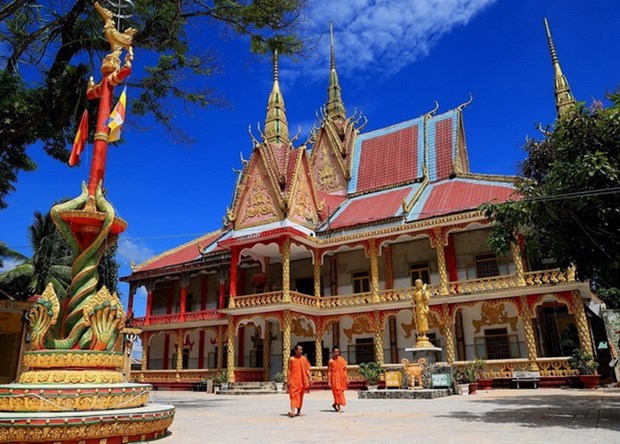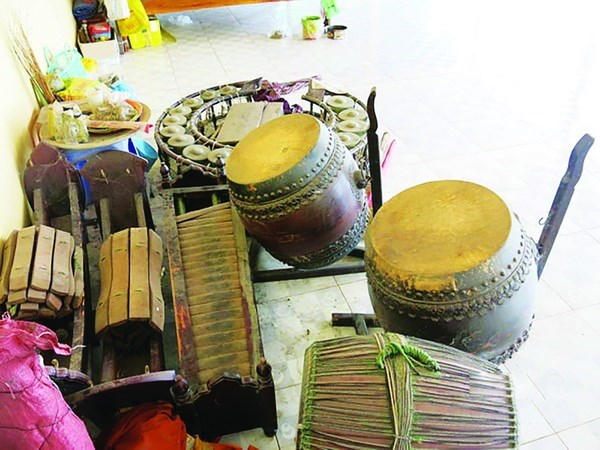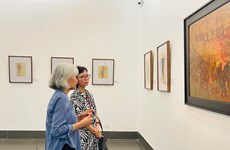Chung Rut Pagoda, a wonder of Khmer cultural characteristics
 Chung Rut Pagoda features some of the most elaborate cultural characteristics among the Khmer pagodas in Tay Ninh province. (Photo: VNA)
Chung Rut Pagoda features some of the most elaborate cultural characteristics among the Khmer pagodas in Tay Ninh province. (Photo: VNA)Hanoi (VNA) - Touching upon the Khmer culture in the southwestern province of Tay Ninh, one would be remiss not to mention the most popular tourist attraction of the region – pagodas. For the Khmer people, pagodas hold a very important position in their spiritual life, serving as a venue for community cultural activities and a place to maintain their cultural identity.
Tay Ninh is home to six beautiful Khmer pagodas in Tan Bien, Tan Chau, and Chau Thanh districts, and Tay Ninh city. All were built in the Khmer Buddhist cultural architecture. The main hall of Botum Kiri Rangsay Pagoda in Thanh Tan is the largest and most splendid, while Chung Rut Pagoda in Hoa Hiep commune, Tan Bien district, is the concentration of the most cultural factors.
The full name of Chung Rut Pagoda is Risathia Ratanaut Dom Chung Rut Risathia Ratanaut. Dom means “noble pressing”, and Chung Rut means “rice basket”. In Hoa Hiep commune, there used to be two ponds, namely Tro Peng Som and Chung Ruk, in the two dwelling areas of Soc Thiet and Chung Ruk villages of Khmer people who have long lived there.
The pagoda derives its name from the fact that in the wartime, farmers harvested rice and stored it in square baskets right in the field instead of bringing it home. The current pagoda was built on the ground of the former village.
In 1990, Chung Rut Pagoda was built from wood, and it was repaired and upgraded over the years.
The Chung Rut can be described as one of the most beautiful Khmer pagodas in the province with the thickest layer of tradition and culture. The gate of the pagoda bears three towers representing Buddha, religion, and followers. On the two sides of the gate are the two statues of fairies in the shape of a bird, decorated with many very sophisticated patterns. Its main hall sees the combination of wood and concrete on a raised and firm foundation.
 The gate of the pagoda bears three towers representing Buddha, religion and followers. On the two sides of the gate are the two statues of fairies in the shape of a bird, decorated with many very sophisticated patterns. (Photo: VNA).
The gate of the pagoda bears three towers representing Buddha, religion and followers. On the two sides of the gate are the two statues of fairies in the shape of a bird, decorated with many very sophisticated patterns. (Photo: VNA).The fence of the pagoda bears images of the seven-head Narar snake symbolising an endless water source. On top of the pagoda is an image of water spraying Rehu holding half of the moon in its mouth. Pillars supporting the roof of the pagoda bear the image of Garuda, mixed with those of beautiful fairies. The main hall of the pagoda houses many statues of Buddha Amitabha in various positions, many of them made of stone, imbued with the Khmer artistic style.
The walls of the pagoda see a harmonious combination of many frescos telling the story on the enlightenment process of Buddha, rich in artistic value and deep in the Khmer style.
Of special note about the pagoda are very sophisticated wood sculptures of a high value.
Besides the fine art works, Chung Rut Pagoda also boasts two other tangible cultural heritages, namely the five-instrument orchestra and a set of Sko Chhay Dam drums.
In the Khmer culture, the five-instrument orchestra, called Pin Piet, goes back in history to a very long time ago. The instruments are made from bronze and wood, connected to one another to form a semicircle. A performer will use two wooden sticks to play the instruments.
The orchestra used to perform in important events, but now it has become more often.
 The five-instrument orchestra.
The five-instrument orchestra.Besides the five-instrument orchestra is a set of Sko Chhay Dam drums and a 16-member dancing troupe who perform on various terrains. The martial art like acrobatic performance is an indispensable part in the time-honored festivals of the Khmer people./.













